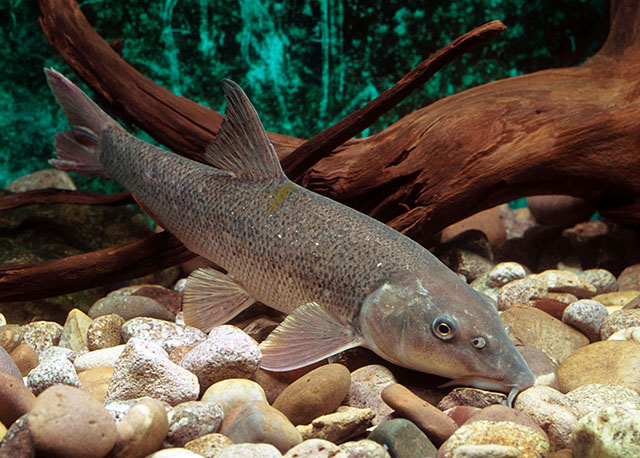| Cyprinidae (Minnows or carps), subfamily: Barbinae |
| 120 cm TL (male/unsexed); max.weight: 12 kg; max. reported age: 15 years |
|
benthopelagic; freshwater; depth range - 10 m, potamodromous |
| Europe: North of the Pyrénées and Alps, from Adour (France) eastward to Neman (Lithuania, Russia) drainages, in rivers draining to Atlantic, North sea and southern Baltic Sea; Danube to Dniepr drainages in northern Black Sea basin; southeastern England north to Yorkshire. Found almost throughout Mediterranean drainages of France. Locally introduced in northern and central Italy, rivers Wear, Tees and Medway and most western drainages of England. |
|
Dorsal spines (total): 3-4; Dorsal soft rays (total): 7-9; Anal spines: 2-3; Anal soft rays: 5-6; Vertebrae: 46-47. Diagnosed from its congeners in France, Great Britain, Black, North, Baltic and Adriatic Sea basins and Apennine Peninsula by having the following characters: lower lip thick with a median swollen pad; tip of dorsal pointed; posterior margin of dorsal concave; last simple dorsal ray spinous, serrated along entire posterior edge; flexible segmented part of last simple dorsal ray about 20-24% of its length; fine dark spots (or no spots) in individuals larger than 10 cm SL; 53-63 total scales on lateral line; 12-14 scale rows between dorsal origin and lateral line; pelvic origin about below dorsal origin; scales with free posterior part pointed; scales on back with 1-5 well developed median longitudinal epithelial crests (Ref. 59043). Caudal fin with 19-20 rays (Ref. 2196). |
| Inhabits from premontane to lowland reaches of clear, warm, medium sized to large rivers with fast current and gravel bottom. Occasionally found in lakes. Frequently overwinters in large group, inactive or active in slow-flowing river habitats. Adults often form shoal, hiding under overhanging trees or bridges during the day. Adults are encountered most active during dusk and dawn while larvae and juveniles are active during both day and night. Larvae and juvenile stay on the bottom in very shallow shoreline habitats and leave the shores for faster-flowing waters as they grow (Ref. 59043). Lives in the deeper, faster-flowing upper reaches of rivers with stony or gravel bottom (barbel zones). Feeds chiefly on benthic invertebrates, such as small crustaceans, insect larvae, mollusks, mayfly and midge larvae (Ref. 6258) and also on small fish and sometimes algae (Ref. 59043). Spawns usually in very shallow, fast-flowing riffles (Ref. 59043). Spawning occurs from May to July after the fish have migrated upriver (Ref. 556). Eggs are poisonous (Refs. 4537, 6258). Locally threatened due to water pollution and river regulation, especially in Baltic drainages, Elbe, South Bug and Dniepr, and heavily impacted by pollution in central Europe but recovering. Population has declined sharply due to construction of large reservoirs and pollution during 20th century and has stabilized at a moderate level since then (Ref. 59043). |
|
Least Concern (LC); Date assessed: 05 March 2010 Ref. (130435)
|
| other |
Source and more info: www.fishbase.org. For personal, classroom, and other internal use only. Not for publication.
